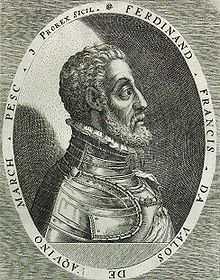Fernando d'Avalos

Fernando Francesco d'Ávalos, V marquis of Pescara (or Ferrante Francesco d'Ávalos; Spanish: Francisco Fernando d'Ávalos,[1] 1489 – 3 December 1525), was an Italian condottiero of Spanish extraction. As a general of the Spanish army, he participated in the Italian Wars. At the Battle of Ravenna in 1512 he was taken prisoner by the French, but was released at the conclusion of the War of the League of Cambrai. He was the chief commander of the Habsburg armies in Italy during the Habsburg-Valois Wars and defeated the French at Bicocca and Pavia.
Biography
Fernando was born at Naples, but his family was of Aragonese origin, having arrived in southern Italy with Alfonso V's general Iñigo d'Avalos, his grandfather. Fernando's father was Alfonso d'Ávalos d'Aquino, IV marquis of Pescara (not to be confused with Alfonso d'Avalos, VI marquess of Pescara and a cousin of Fernando).
At the age of six the boy was betrothed to Vittoria Colonna, daughter of the general Fabrizio Colonna, and the marriage was celebrated in 1509 on the island of Ischia. His position as a noble of the Aragonese party in Naples made it incumbent on him to support Ferdinand the Catholic in his Italian wars. In 1512, he commanded a body of light cavalry at the battle of Ravenna, where he was wounded and taken prisoner by the French. Thanks to the intervention of one of the foremost of the French generals, the Italian G. G. Trivulzio, who was his connection by marriage, he was allowed to ransom himself for 6,000 ducats.
He commanded the Spanish infantry at the Battle of La Motta, or Vicenza, on 7 October 1513. It was on this occasion that he called his men before the charge to take care to step on him before the enemy did if he fell. From the battle of Vicenza in 1513, down to the Battle of Bicocca on 29 April 1522, he continued to serve in command of the Spaniards and as the colleague rather than the subordinate of Prospero Colonna.
After the battle of Bicocca Charles V appointed Colonna commander-in-chief. D'Ávalos, who considered himself aggrieved, made a journey to Valladolid in Spain, where the emperor then was, to state his own claims. Charles V, with whom he had long and confidential interviews, persuaded him to submit for the time to the superiority of Colonna. But in these meetings he gained the confidence of Charles V. His Spanish descent and sympathies marked him out as a safer commander of the imperial troops in Italy than an Italian could have been.
When Francis I invaded Italy in 1524 D'Ávalos was appointed as lieutenant of the emperor to repel the invasion. The difficulties of his position were very great, for there was much discontent in the army, which was very ill-paid. The tenacity, patience and tact of D'Ávalos triumphed over all obstacles. His influence over the veteran Spanish troops and the German mercenaries kept them loyal during the long siege of Pavia.
On 24 February 1525 he defeated and took prisoner Francis I by a brilliant attack. D'Ávalos' plan was remarkable for its audacity and for the skill he showed in destroying the superior French heavy cavalry by assailing them in flank with a mixed force of harquebusiers and light horse. It was believed that he was dissatisfied with the treatment he had received from the emperor; and Girolamo Morone, secretary to the duke of Milan, approached him with a scheme for expelling French, Spaniards and Germans alike from Italy, and for gaining a throne for himself. d'Ávalos may have listened to the tempter, but in act he was loyal. He reported the offer to Charles V and put Morone into prison. His health, however, had begun to give way under the strain of wounds and exposure, during late November, and he died at Milan on 3 December 1525. d'Ávalos had no children; his title descended to his cousin Alfonso D'Ávalos, Marquis del Vasto, also a distinguished imperial general (who in fact led the Imperialist musketeers at Pavia).
In literature
The Italian historiographer Paolo Giovio published a contemporary biography in Latin of Fernando Francesco which was included in his Vitae (illustrium virorum).[2] It was subsequently translated by Lodovico Domenichi and published in Florence in 1551.[3] Giovio's biography was also translated into Spanish by Pedro de Vallés in 1553 as Historia del fortissimo y prudentissimo capitan Don Hernando de Avalos.[4]
References
- ↑ Zimmerman, T. C. Price (1995). Paolo Giovio: The Historian and the Crisis of Sixteenth-Century Italy. Princeton, NJ: Princeton University Press. p. 87. ISBN 9781400821839.
- ↑ Chrisholm, Hugh, ed. (1911). "Pescara, Fernando Francesco Davalos, Marquis of". Encyclopædia Britannica. 21.4 (Perry - Petrie) (11th ed.). Retrieved 18 July 2013.
- ↑ Giovio, Paolo (1557). Domenichi, Lodovico, ed. La vita del Signor Don Ferrando Davalo Marchese di Pescara, scritta per Mons. Paolo Giovio, Vescovo di Nocera, et tradotta per M. Lodovico Domenichi con la travoladelle cose natabili. (in Italian). Giovanni de' Rossi.
- ↑ de Vallés, Pedro (1570). Historia del fortissimo, y prudentissimo capitan don Hernando de Avalos marques de Pescara, con los hechos memorables de otros fiete excell. capitanes del Emperador don Carlos V ... con una adicion hecha por Diego de Fuentes (in Spanish). Phil. Nutius.
- Taylor, Frederick Lewis. The Art of War in Italy, 1494-1529. Westport: Greenwood Press, 1973. ISBN 0-8371-5025-6.
 This article incorporates text from a publication now in the public domain: Chisholm, Hugh, ed. (1911). Encyclopædia Britannica (11th ed.). Cambridge University Press
This article incorporates text from a publication now in the public domain: Chisholm, Hugh, ed. (1911). Encyclopædia Britannica (11th ed.). Cambridge University Press
|